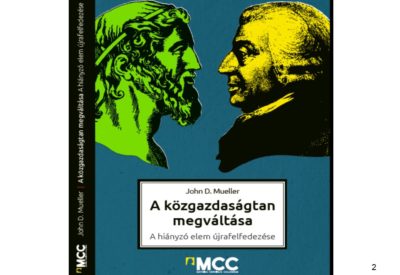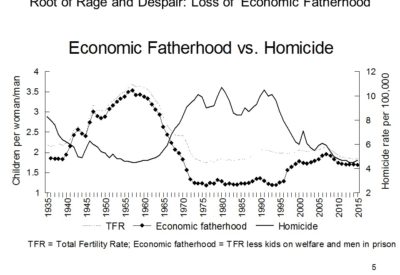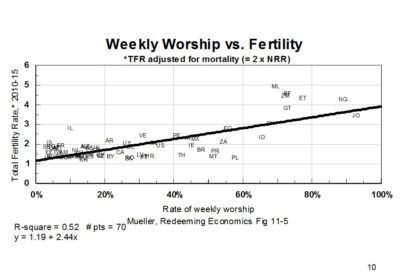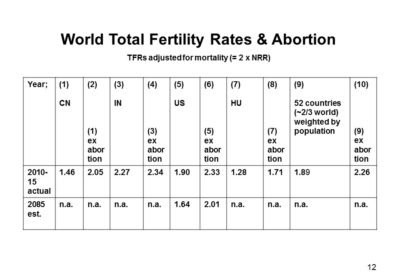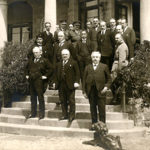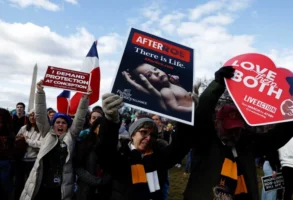
Published May 26, 2017
World Congress of Families XI
The following presentation was delivered on behalf of EPPC Lehrman Institute Fellow in Economics John D. Mueller as part of the Panel on Family, Population and Demographics at the World Congress of Families XI in Budapest, Hungary, on May 26, 2017.
(Click images to enlarge)
I’m pleased to see so many old friends at another World Congress of Families, particularly here in Budapest, a city I learned to love last year when the Matthias Corvinus Collegium published the Hungarian translation of my book Redeeming Economics.[1]
At the World Congresses of Families in Warsaw,[2] Amsterdam,[3] Madrid,[4] and Salt Lake City,[5] as well as the demographic summits in Moscow and Ulyanovsk,[6] I presented and updated a country-by-country model of fertility, which was published in my book.
Today, I’d like to use that model to conduct “A Brief Demographic Tour of the World,” and examine the main reasons why most countries—now including the United States, as my book correctly predicted—have fallen into “demographic winter.”
Seventeen years ago I published a paper on the “Socioeconomic Costs of Roe v. Wade.” In it, I estimated the impact of legal abortion in reducing the U.S. population (about 20% so far) and concluded, “taken in its entirety, legal abortion is perhaps the single largest American economic event of the past century, more significant than the Great Depression or the Second World War.”[7] Unfortunately, the same can now be said of the whole world.
The cover of the American edition of my book features Gustave Doré’s engraving, “Arrival of the Good Samaritan at the Inn.” Transcending nationality and religion, the parable illustrates all the possible economic transactions we can have with our fellow man: the robbers beating a man and leaving him for dead illustrate crime; the priest and Levite who passed him by illustrate indifference; the innkeeper’s bargain with the Samaritan illustrates justice in exchange; and finally, the Samaritan’s devotion of time and money to restore the beaten man to life illustrates a gift. Crime, indifference, just exchange, and gift: this is the range of possible transactions, described by St. Augustine and incorporated by Thomas Aquinas in the original scholastic economics.[8]
In contrast, the premise of modern economic theory was expressed by Adam Smith’s famous assumption in the Wealth of Nations that “every individual . . . intends only his own gain.”[9] “Neoscholastic” economics differs from Smith’s “classical” and today’s “neoclassical” economics chiefly in retaining Augustine and Aristotle’s theory of distribution: comprising gifts (and their opposite, crimes) and what Aristotle called “distributive justice” as well as economic exchanges. This also makes the neoscholastic theory much more accurate.
For example, updating scholastic economic theory refutes the famous claim by economist Steven D. Levitt, featured in his megabestseller Freakonomics, that the U.S. Supreme Court’s legalization of abortion in 1973 caused the crime rate to fall 15-20 years later, by eliminating potential criminals.[10]
In fact, I showed, there is a strong current inverse relation between “economic fatherhood” and the homicide rate.[11] Legalizing abortion raised crime rates almost immediately, by turning new fathers back into men without dependent children—a small but steady share of whom commit murder.
Although we might say that rage has declined recently, as measured by the homicide rate, at the same time, despair has increased, as measured by the suicide rate—attested also by other “deaths of despair,” such as overdoses of opioids and other addictive drugs. As a result, the total rage and despair—the total tradeoff between economic fatherhood and violent death, measured by the homicide plus suicide rates—is almost unchanged.
Like the “neoscholastic” theory of crime, the “neoscholastic” fertility model is also more accurate than existing neoclassical models, because it recognizes the centrality of gifts within daily life. Just four factors explain most variation in birth rates among the countries for which sufficient data are available (comprising about one-third of all countries, but more than three-quarters of world population).[12]
The birth rate is strongly and about equally inversely proportional to per capita social benefits and per capita national saving (both adjusted for differences in purchasing power), which represent provision by current adults for their own well-being.
When these factors are taken into account, a legacy of totalitarian government is also highly significant, reducing the birth rate by about 0.4 children per couple.
Finally, the birth rate is strongly and positively related to the rate of weekly worship. This is because all gifts of scarce resources—whether rearing a child or worship—require the same lowering of self and raising of others in our scale of preferences for persons. On average throughout the world in 2010-15 (adjusted for differences in mortality), a couple which never worshipped had an average of 1.2 children; but the average couple which worshipped at least once a week had 2.4 more—an average of 3.6 children.[13]
There are four main reasons, then, for “demographic winter,” in order of importance: First, low rates of religious practice, which are associated with low birth rates (and high incidence of abortion); second, social benefits so high as to displace gifts within the family, particularly the gift of life; third, legacies of totalitarianism; and finally, finally, heavy reliance on fiscal policies which penalize investment in people: so-called “human capital.”
What does this mean for policy? Based on current projections, the federal budget would substantially increase federal social benefits as a share of GDP. Because of the strong inverse relation between the birth rate and per capita social benefits, I project that the U.S. birth rate will fall significantly under current law, from about 1.83 to about 1.64 children per couple. These projections indicate that the budget is likely to shift U.S. society to conditions approximating the Social Security Trustees’ “High-Cost Assumptions.” The same lessons apply in many other countries.
At the Ulyanovsk Demographic Summit in 2012, I warned against the natural tendency to seek special privileges for one’s own religion. “To practice one’s religion in America, one must really want to be a Protestant or Catholic or Muslim or Jew; the practice of other faiths stimulates practice of one’s own faith; and one finds that one often has much more in common politically with members of other faiths who are serious about practicing their own faiths than with one’s co-religionists who are not.”
Alexis de Tocqueville rightly worried that in his native France, “Catholicism, I am very afraid, will never adopt the new society. It will never forget the position that it had in the old one and every time that [it] is given some powers, it will hasten to abuse them.”[14] I remarked that a similar temptation and danger seem to exist today, because of its similar history, for the Russian Orthodox Church (with which about 95 per cent of Russia’s Christians identify,[15] but in which the rate of weekly worship is less than 5 per cent. Both Tocqueville’s analysis and recent international experience imply that by forswearing political privileges or penalties on other denominations or cults, the Russian Orthodox Church (and by extension other nationally established churches) would be surprised to see Russian religious practice rise significantly, and that the vast majority of the additional practitioners would be Orthodox.
Fifty years ago, the three most populous countries were China, India, and the United States. That’s still true today. But the practice of abortion in China but not as widely in India is causing a reversal of their first and second population ranks.
Adjusted for differences in mortality rates, in 2010-15 China’s TFR was 1.46 after but 2.01 before abortions; India’s 2.27 after and 2.34 before abortions, the USA 1.90 after but 2.33 before abortions, and 4th-largest Indonesia’s 2.32 after but 3.46 before abortions.[16] Hungary is among the few countries for which abortion alone does not explain the whole difference between a shrinking and growing population. Based on all countries for which data are available (comprising about two-thirds of world population), the World TFR was 1.89 after, but 2.26 before abortions. So the good news is that the rate of legal abortion has fallen by nearly half from its peak; the bad news is that this still makes the difference between a declining and growing population—both for my country, the USA, and for the whole world.
Economics has been called the ‘dismal science.’ But I like to emphasize that my message is one of hope. By identifying the root causes of rage and violence, and of “demographic winter,” we can restore well-founded hope that our future can be better than the recent past.
[1] John D. Mueller, Redeeming Economics: Rediscovering the Missing Element, ISI Books, Wilmington, DE, 2014 [2010] http://www.amazon.com/Redeeming-Economics-Rediscovering-Missing-Enterprise/dp/1932236945
[2] John D. Mueller, “A Family-Friendly Fiscal Policy to Weather Demographic Winter,” remarks to the Fourth World Congress of Families, Warsaw, Poland, 11 May 2007, http:/ /www.worldcongress.org/wcf4.spkrs/wcf4.mueller.htm, and http://www.eppc-stage.local/publications/pubID.2937/pub_detail.asp.
[3] John D. Mueller, “How Do Nations Choose ‘Demographic Winter’? Is America Doing So?” Remarks at the Fifth World Congress of Families Panel on “Family and Demography,” Amsterdam,, Netherlands, 11 August 2009, http://www.worldcongress.org/wcf5.spkrs/wcf5.mueller.htm and http://www.eppc-stage.local/publications/pubID.3911/pub_detail.asp
[4] John D. Mueller, “Babies and Dollars: Babies and Dollars: Implications for USA, Russia, and the World,” available at http://demographia.ru/eng/articles/index.html?idR=80&idArt=1946 and http://www.eppc-stage.local/programs/economics/publications/programID.41,pubID.4522/pub_detail.asp.
[5] “It’s Marriage, Stupid!” https://eppc.org/publications/its-marriage-stupid/, https://www.youtube.com/watch?v=y1p1EaqHwvo, and “The Socioeconomic Costs of Legal Abortion,” https://www.youtube.com/watch?v=xLEkdZK4R2U&t=939s. published in The Family in America, http://familyinamerica.org/journals/winter-2016/social-and-economic-costs-legal-abortion/#.WRXXr9LyuyI
[6] John D. Mueller, “Tocqueville’s Comparison of America and Russia, Updated,” Ulyanovsk International Demographic Conference, September 25, 2012. https://eppc.org/publications/tocquevilles-comparison-of-america-and-russia-updated/
[7] John Mueller, “The Socioeconomic Costs of Roe v. Wade,” Family Policy, Vol. 13 No. 2, March-April 2000, 1-20. https://eppc.org/publications/the-socioeconomic-costs-of-roe-v-wade/
[8] As Augustine noted, a crime is the opposite of a gift: taking from other persons their own goods. As with “legal” abortion, the objective facts remain the same whether or not the crime is recognized as such by human law. Augustine, On Christian Doctrine 3. 10. 16 (Grand Rapids: Christian Classics Ethereal Library), pp. 396-97, http://www.ccel.org/ccel/augustine/doctrine.xi_2.html.
[9] Smith, A. (1966 [1776], Smith, Wealth of Nations, IV.ii.9, accessed on 19 September 2009
from http://www.econlib.org/library/Smith/smWN13.html#IV.2.9.
[10] Steven D. Levitt and Stephen J. Dubner, Freakonomics: A Rogue Economist Explores the Hidden Side of Everything (William Morrow, New York, 2005), 117-144.
[11] “Economic” fatherhood is defined not by biological paternity nor residency with but provision for one’s children. Specifically, “economic fatherhood” equals the total fertility rate, with fertility rates for white and nonwhites mixed in the same proportion as among men admitted to prison, removing children on welfare (who are not supported by their fathers) from the numerator and men in prison (who cannot support their children) from the denominator.
[12] The model was first published in John D. Mueller, “How Does Fiscal Policy Affect the American Worker?” Notre Dame Journal of Law, Ethics and Public Policy Vol. 20 No. 2 (Spring 2006), 563-619; available at http://www.eppc-stage.local/publications/pubID.2671/pub_detail.asp
[13] Regular worship is not only positively related to fertility in a roughly linear fashion. It is also inversely related to the incidence of abortion, which (like crime in general) rises exponentially as the rate of worship declines. Data on abortion rates by country from “Abortion statistics and other data,” by Wm. Robert Johnston. Updated 2017, available at http://www.johnstonsarchive.net/policy/abortion/wrjp336pd.html.
[14] Alexis de Tocqueville, Democracy in America, op. cit., Vol. 3. Chapter 6: “Of the Progress of Catholicism in the United States,” accessed from http://oll.libertyfund.org/title/2287/218955 on 2012-09-09
[15] http://features.pewforum.org/global-christianity/population-number.php; see also World Values Survey (WVS): http://www.worldvaluessurvey.org/wvs.jsp and European Values Survey (EVS). Unfortunately, the EVS has not been updated since 2008.
[16] Fertility rates should be adjusted for differences in mortality rates. The Net Reproduction Rate (NRR) represents a hypothetical woman whose experience matches the average rates of fertility and death of all women in a given year. (The Total Fertility Rate measures fertility alone.) An NRR of 1.00 indicates that each woman bears exactly one surviving daughter. The Total Fertility Rates used in the model equal twice the NRR. For example, the TFR in Mali in 2006 was 7.42, but the NRR was 1.987, which corresponds to a TFR of 3.97 children per couple. In other words, in Mali the typical couple had about 3-1/2 children simply to compensate for the likelihood of premature death before reaching child-bearing age. United Nations, Department of Economic and Social Affairs, Population Division, World Population Prospects: http://data.un.org/Data.aspx?d=PopDiv&f=variableID%3A48

